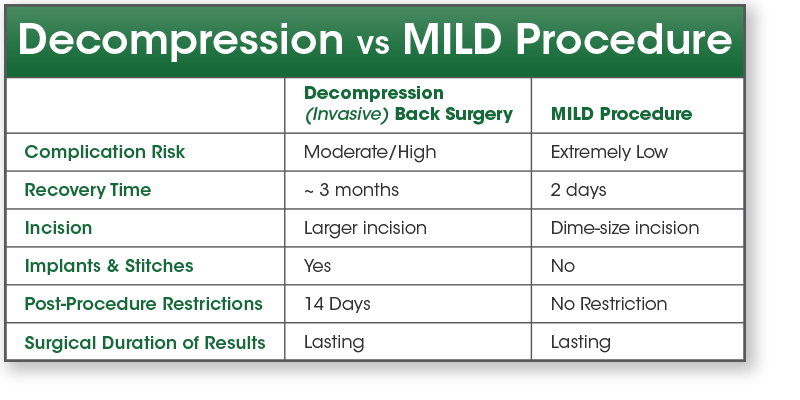
When exploring medical treatments for lower back and leg pain, there are many factors to consider. Any surgery can cause complications, but when surgery is done near the spine and spinal cord, the risk can be extremely high. Recovery time, complication risk, and duration of results are just a few factors that can greatly impact your health if they are not mitigated.
Invasive back surgery can pose many serious complications. Elements such as metal screws, plates, and rods are used to keep the spine aligned. These devices can break over time, which could require a secondary operation to remove or replace the hardware. Most surgeries also require general anesthesia (where you are completely asleep for the procedure), and some patients can have aversive reactions to drugs or have secondary problems due to other medical conditions. Blood clotting can also cause problems for surgical candidates. The risk of developing a clot is much higher in surgeries in lower extremities and can block the blood in your legs from going to your heart. Other complications include infection, spinal cord injury, persistent pain, implant migration, and many others.

How Can You Avoid Invasive Surgery?
There are many forms of therapy that can be attempted before looking into invasive surgery. The emergence of non-invasive procedures over the past few decades have allowed patients to receive long-term benefits with minimal recovery time. These procedures limit anesthesia use, risk of infection, pain, and surgical complications. When paired with physical rehabilitation, the need for surgical intervention can be postponed or even eliminated altogether.
It is always recommended to discuss your options with your physician, as people can respond differently to procedures based on their medical history.
What Do We Offer At DOC?
At Dayton Outpatient Center, we provide a variety of minimally invasive treatments to provide solutions for lower back and leg pain.
Epidural Steroid Injection
Epidural steroid injections (ESIs) are a non-invasive and common treatment for lower back and leg pain. Research shows that 70% to 90% of patients experience pain relief from these injections, lasting from a week to a year. Typically, patients can receive up to 3 injections over a 12-month period. The injections do not require any implants or stitches, and the recovery and post-procedure restrictions are minimal.
With the use of a local anesthetic, the medication is injected directly into the epidural space that surrounds the spinal cord and nerve roots. The steroid helps control pain by reducing inflammation around the nerve roots. Following the treatment, patients see an improvement in mobility and function in the lower back and legs and may feel comfortable to progress into physical therapy.
MILD
The minimally invasive lumbar decompression (MILD) procedure is a low-risk treatment option for Lumbar Spinal Stenosis (LSS). LSS is a common cause of lower back and leg pain when there is a narrowing of the central canal of the lumbar spine or lower back. The MILD procedure relieves pressure on the spine by removing ligament tissue to restore space in the spinal canal. It is an outpatient procedure, taking less than one hour to complete and leaves a small scar, about the size of a baby aspirin. It is minimally invasive and does not require general anesthesia, implants, stitches, steroids, or opioids. The recovery time for this procedure can be as short as 24 hours and provide lasting relief.



